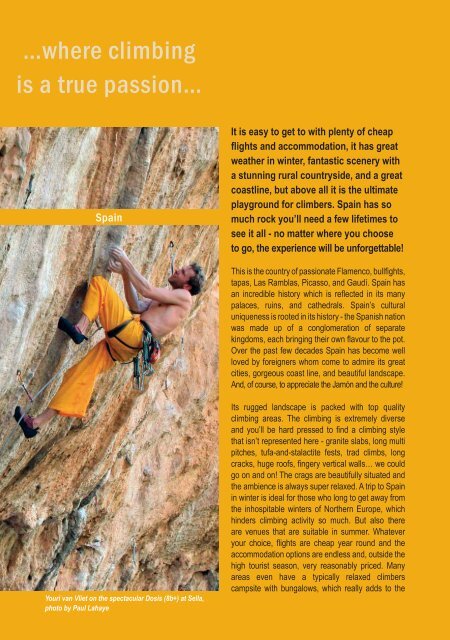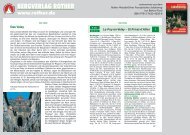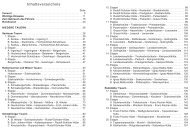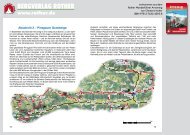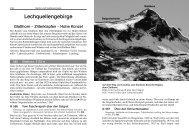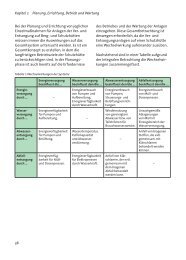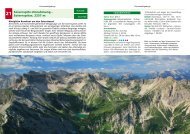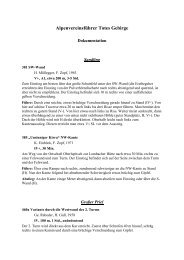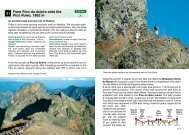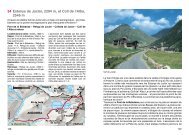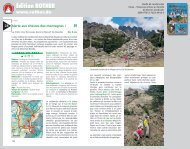…where climbing is a true passion…
…where climbing is a true passion…
…where climbing is a true passion…
Create successful ePaper yourself
Turn your PDF publications into a flip-book with our unique Google optimized e-Paper software.
<strong>…where</strong> <strong>climbing</strong><br />
<strong>is</strong> a <strong>true</strong> <strong>passion…</strong><br />
Spain<br />
Youri van Vliet on the spectacular Dos<strong>is</strong> (8b+) at Sella,<br />
photo by Paul Lahaye<br />
It <strong>is</strong> easy to get to with plenty of cheap<br />
fl ights and accommodation, it has great<br />
weather in winter, fantastic scenery with<br />
a stunning rural countryside, and a great<br />
coastline, but above all it <strong>is</strong> the ultimate<br />
playground for climbers. Spain has so<br />
much rock you’ll need a few lifetimes to<br />
see it all - no matter where you choose<br />
to go, the experience will be unforgettable!<br />
Th<strong>is</strong> <strong>is</strong> the country of passionate Flamenco, bullfi ghts,<br />
tapas, Las Ramblas, Picasso, and Gaudí. Spain has<br />
an incredible h<strong>is</strong>tory which <strong>is</strong> refl ected in its many<br />
palaces, ruins, and cathedrals. Spain’s cultural<br />
uniqueness <strong>is</strong> rooted in its h<strong>is</strong>tory - the Span<strong>is</strong>h nation<br />
was made up of a conglomeration of separate<br />
kingdoms, each bringing their own fl avour to the pot.<br />
Over the past few decades Spain has become well<br />
loved by foreigners whom come to admire its great<br />
cities, gorgeous coast line, and beautiful landscape.<br />
And, of course, to appreciate the Jamón and the culture!<br />
Its rugged landscape <strong>is</strong> packed with top quality<br />
<strong>climbing</strong> areas. The <strong>climbing</strong> <strong>is</strong> extremely diverse<br />
and you’ll be hard pressed to fi nd a <strong>climbing</strong> style<br />
that <strong>is</strong>n’t represented here - granite slabs, long multi<br />
pitches, tufa-and-stalactite fests, trad climbs, long<br />
cracks, huge roofs, fi ngery vertical walls… we could<br />
go on and on! The crags are beautifully situated and<br />
the ambience <strong>is</strong> always super relaxed. A trip to Spain<br />
in winter <strong>is</strong> ideal for those who long to get away from<br />
the inhospitable winters of Northern Europe, which<br />
hinders <strong>climbing</strong> activity so much. But also there<br />
are venues that are suitable in summer. Whatever<br />
your choice, fl ights are cheap year round and the<br />
accommodation options are endless and, outside the<br />
high tour<strong>is</strong>t season, very reasonably priced. Many<br />
areas even have a typically relaxed climbers<br />
campsite with bungalows, which really adds to the
holiday feeling. Yes, Spain <strong>is</strong> defi nitely one of those<br />
countries that make you want to come back to over<br />
and over again.<br />
Climbing information<br />
Climbing <strong>is</strong> possible almost everywhere in Spain -<br />
from the Pyrenees to the Canary Islands and from<br />
the Mediterranean to the North Atlantic coastline.<br />
Actually it sometimes feels as if the whole country<br />
<strong>is</strong> made out of rock and despite there being hundreds<br />
of developed crags there seems to be unlimited<br />
rock waiting to be climbed. The Span<strong>is</strong>h themselves<br />
are, unsurpr<strong>is</strong>ingly, very able and strong climbers<br />
- have a look at the world sport <strong>climbing</strong> ranking<br />
l<strong>is</strong>t of the UIAA!<br />
Most of the rock <strong>is</strong> good quality limestone but there <strong>is</strong><br />
also granite and conglomerate to be found. In general<br />
the routes are always very well bolted and have<br />
good lower-offs, which makes it a perfect place to try<br />
harder stuff and push your limits with confi dence.<br />
Since Spain has so many <strong>climbing</strong> areas it <strong>is</strong><br />
an almost impossible task to choose the best.<br />
Nevertheless we have tried to give an overview of,<br />
in our opinion, the most interesting and unique areas.<br />
Climbing area Pre-Pyrenees<br />
In the north the foothills of the Pyrenees host a<br />
number of impressive crags. Not far away from<br />
the French border, Riglos and Rodellar, both have<br />
some fantastic <strong>climbing</strong>. Riglos <strong>is</strong> exceptional for its<br />
huge red-coloured conglomerate pillars. Rodellar<br />
<strong>is</strong> without doubt one of the best sport <strong>climbing</strong><br />
destinations in Europe.<br />
Climbing area Madrid<br />
The best crags around Madrid, La Pedriza and<br />
Patones, are situated north of the capital. Each<br />
offers a completely different style of <strong>climbing</strong> - from<br />
pure slab <strong>climbing</strong> to technical moves on steep<br />
and overhanging rock! It <strong>is</strong> a great opportunity to<br />
combine good <strong>climbing</strong> with a v<strong>is</strong>it to Madrid.<br />
Climbing area Malaga<br />
Malaga <strong>is</strong> home to the world famous El Chorro.<br />
Th<strong>is</strong> fantastic place offers all a climber could dream<br />
for! The setting in a deep gorge <strong>is</strong> simply stunning<br />
and the <strong>climbing</strong> <strong>is</strong> tremendous. Another fabulous<br />
nearby crag, Desplomilandia, makes your whole<br />
trip complete.<br />
Climbing area Costa Blanca<br />
The Costa Blanca <strong>is</strong> mainly known for its beautiful<br />
coast line with the most stable winter weather in<br />
Spain. It also has some very nice crags, such as<br />
Sella, Sierra de Toix, and Gandia.<br />
Climbing area València<br />
Hidden away about a two hour drive inland from<br />
València <strong>is</strong> the best bouldering destination in Spain.<br />
Some even say that Albarracin <strong>is</strong> only second in<br />
Europe after Fontainebleau for bouldering. Closer<br />
to València you’ll fi nd Montanejos, with a large<br />
number of sport and traditional routes where one<br />
can happily spend a few months.<br />
Climbing area Costa Daurada<br />
South west of Barcelona are two supreme crags -<br />
Siurana and Montsant. Th<strong>is</strong> <strong>is</strong> one of the cheapest<br />
and easiest to reach destinations in Spain, favoured<br />
by many. Siurana <strong>is</strong> already widely known for its<br />
fantastic limestone and incredibly chilled atmosphere.<br />
Nearby Montsant <strong>is</strong> still a secret to some but <strong>is</strong> also<br />
on its way to becoming one of Spain’s top venues.<br />
Climbing area Mallorca<br />
The <strong>is</strong>land of Mallorca situated in the Mediterranean<br />
Sea provides truly excellent rock <strong>climbing</strong> in beautiful<br />
surroundings. It <strong>is</strong> a good choice for both families<br />
and hard rock climbers, and for those who enjoy<br />
good nightlife. It also has fantastic deep water solo<br />
possibilities.<br />
Spain | Introduction<br />
265
Spain | Introduction<br />
266<br />
La Coruña<br />
Portugal<br />
Huelva<br />
Badajoz<br />
Canary <strong>is</strong>lands,<br />
Tenerife 21<br />
Oviedo<br />
Cádiz<br />
León<br />
Sevilla<br />
Spain<br />
Gijón<br />
1<br />
Morocco<br />
Salamanca<br />
Gibraltar<br />
2<br />
Antequera<br />
20<br />
Torrelaguna<br />
Córdoba<br />
Loja<br />
Madrid<br />
19<br />
Málaga<br />
Santander<br />
10<br />
Burgos<br />
Jaén<br />
17<br />
18<br />
Granada<br />
Bilbao<br />
Pamplona<br />
San Sebastian<br />
3<br />
Morata de Jalon<br />
9<br />
11<br />
Cuenca 12<br />
Almeria<br />
Teruel<br />
Murcia<br />
16
4<br />
Zaragoza lleida<br />
Alicante<br />
Cartagena<br />
Valencia<br />
France<br />
Huesca Barbastro<br />
Jérica<br />
13<br />
15<br />
5<br />
Benidorm<br />
6<br />
8<br />
Reus<br />
Tarragona<br />
Andorra<br />
Algeria<br />
7<br />
Barcelona<br />
Palma de Mallorca<br />
14<br />
1 ●<br />
2 ●<br />
3 ●<br />
4 ●<br />
5 ●<br />
6 ●<br />
7 ●<br />
8 ●<br />
9 ●<br />
10 ●<br />
11 ●<br />
12 ●<br />
13 ●<br />
14 ●<br />
15 ●<br />
16 ●<br />
17 ●<br />
18 ●<br />
19 ●<br />
20 ●<br />
21 ●<br />
Climbing area Routes<br />
Valdehuesa<br />
Picos de Europa<br />
Etxauri<br />
Pre-Pyrenees<br />
Rodellar<br />
Riglos<br />
Pared de Aragón<br />
Cavallers<br />
Montserrat<br />
Costa Daurada<br />
Siurana<br />
Montsant<br />
Morata de Jalón<br />
Madrid<br />
La Pedriza<br />
Patones<br />
Cuenca<br />
València<br />
Albarracín<br />
Montanejos<br />
Jérica<br />
Mallorca<br />
Mallorca<br />
Costa Blanca<br />
Sella<br />
Sierra de Toix<br />
Gandia<br />
Murcia<br />
Castillo de Santa<br />
Peña Cabrera<br />
Loja<br />
Malaga<br />
El Chorro<br />
Desplomilandia<br />
Tenerife<br />
250<br />
750<br />
625<br />
220<br />
164<br />
50<br />
600<br />
379<br />
635<br />
45<br />
350<br />
1800<br />
744<br />
665<br />
1000<br />
1400<br />
220<br />
850<br />
280<br />
179<br />
210<br />
2135<br />
112<br />
68<br />
175<br />
1000<br />
150<br />
803<br />
Note: Th<strong>is</strong> l<strong>is</strong>t only shows<br />
the major <strong>climbing</strong> areas in Spain.<br />
Spain | Introduction<br />
267
Spain | Introduction<br />
268<br />
Climate<br />
Spain can be unbearable hot in high summer. During<br />
the months of July and August most v<strong>is</strong>itors either stay<br />
up high, in any of its mountain ranges, or along the<br />
coast, where the water provides some refreshment.<br />
Roughly speaking the north <strong>is</strong> quite a bit cooler<br />
than the south for the rest of the year. The higher<br />
regions, such as the Pyrenees and Madrid, can get<br />
very cold during winter.<br />
The best time to go <strong>climbing</strong> <strong>is</strong> during spring and<br />
autumn. However <strong>climbing</strong> along the south and the<br />
east coasts in winter can be really pleasant - Spain<br />
<strong>is</strong>, not without reason, a highly favoured winter<br />
<strong>climbing</strong> destination for Northern Europeans. The<br />
worst time for <strong>climbing</strong> generally <strong>is</strong> July and August<br />
but there are still crags that are suitable.<br />
Month<br />
Jan<br />
Feb<br />
March<br />
April<br />
May<br />
June<br />
July<br />
Aug<br />
Sept<br />
Oct<br />
Nov<br />
Dec<br />
The average temperatures along the Mediterranean<br />
coast are a few degrees higher from October to May.<br />
Getting there<br />
By plane<br />
Average<br />
temperature (°C)<br />
6<br />
7<br />
10<br />
12<br />
15<br />
21<br />
24<br />
25<br />
21<br />
14<br />
9<br />
6<br />
Average<br />
rainfall (mm)<br />
35<br />
37<br />
39<br />
44<br />
43<br />
31<br />
11<br />
11<br />
34<br />
47<br />
52<br />
44<br />
Climate table Madrid<br />
A large number of budget airlines operate fl ights<br />
between numerous European cities and several<br />
different Span<strong>is</strong>h destinations. Amongst them are<br />
Ryanair, Easyjet, Thomsonfl y, BmiBaby, Air Berlin,<br />
TUIfl y, Transavia and Vueling.<br />
For the Pre-Pyrenees area the quickest way there<br />
<strong>is</strong> to fl y to Zaragoza but the best deals are often<br />
found to Barcelona. For the crags around Madrid<br />
it <strong>is</strong> naturally best to fl y to Madrid. For El Chorro<br />
fl y to Malaga. Alicante <strong>is</strong> the cheapest and quickest<br />
for any of the crags on the Costa Blanca. For the<br />
bouldering at Albarracin or the sport <strong>climbing</strong> at<br />
Montanejos fl y to València. Book a fl ight to Barcelona<br />
if you are heading for the Costa Daurada and when<br />
going to Mallorca, Palma de Mallorca <strong>is</strong> your place.<br />
If you’re coming from the USA or Canada it often<br />
<strong>is</strong> cheaper to fl y to some European cities outside<br />
Spain, such as London, Dusseldorf, or Amsterdam.<br />
From any of these cities hop on one of the low cost<br />
airlines operating fl ights to a number of Span<strong>is</strong>h<br />
cities. If you choose to fl y directly either Iberia or<br />
Brit<strong>is</strong>h Airways <strong>is</strong> a good starting point for your<br />
search. Iberia now offers round trips from $512<br />
between Madrid and several cities in the USA.<br />
By train<br />
Spain <strong>is</strong> well connected by train from many other<br />
European countries. An excellent website to start<br />
your search <strong>is</strong>: www.re<strong>is</strong>eauskunft.bahn.de. Check<br />
the prices carefully as plane tickets often are a<br />
cheaper and quicker alternative of getting there. The<br />
Spain offers some fantastic sea cliff <strong>climbing</strong><br />
- here at the Costa Blanca, Sierra de Toix
Span<strong>is</strong>h national railways website www.renfe.es<br />
gives information on train schedules within Spain<br />
and some international destinations. If you’re<br />
travelling a lot by rail, a rail pass might work out<br />
cheaper, especially if you are a student - www.interrailnet.com<br />
provides all information.<br />
By bus<br />
Travelling to Spain by bus <strong>is</strong> still popular although<br />
mostly only with younger people. Madrid, and<br />
the cities along the coast - Barcelona, Alicante,<br />
and València - are all popular destinations. Start<br />
searching at www.eurolines.com.<br />
By car<br />
Spain <strong>is</strong> a long drive from most other European<br />
countries but if time <strong>is</strong> on your side then it <strong>is</strong> a very<br />
worthwhile drive. The drive from France into Spain<br />
through the Pyrenees <strong>is</strong> very pleasant indeed,<br />
especially if you take any of the smaller roads like<br />
the D929 / A138 via the Bielsa tunnel.<br />
Moving around<br />
For most areas mentioned in th<strong>is</strong> chapter you’ll<br />
really need to have a car to move around with the<br />
exception of La Pedriza, Montanejos, Siurana and<br />
El Chorro.<br />
Airport information<br />
All Span<strong>is</strong>h airports are modern and well organized,<br />
and it goes without saying that all national and<br />
international car rental agencies are always located<br />
in the arrivals hall. Transport from the airport to the<br />
city centre <strong>is</strong> generally by bus.<br />
By public transport<br />
Spain has an extensive bus and train network<br />
and it <strong>is</strong> usually possible to take a train or bus to<br />
the nearest city. However your own wheels still<br />
Paddy Clarke enjoys evening sunshine on Yellow Arrete (6b),<br />
El Chorro, photo by Eoin Lawless<br />
Spain | Introduction<br />
269
Spain | Introduction<br />
270<br />
come in handy to get from the bus station to your<br />
accommodation or campsite. A lot of climbers also<br />
choose to hitch a ride for th<strong>is</strong> last bit. The national<br />
railway company in Spain <strong>is</strong> called Renfe and their<br />
website www.renfe.es gives train information.<br />
By car<br />
The road conditions in Spain are generally good<br />
with clear road signs. Most roads are toll free<br />
except for several highways along the coast.<br />
Cars can be rented easily at the airports. The best<br />
deals are found on Mallorca where daily rates can<br />
go rock bottom at €20 for the smallest class and<br />
unlimited mileage. On the mainland rates usually<br />
start at €30 per day and €175 per week. Make sure<br />
you book ahead on the internet as th<strong>is</strong> <strong>is</strong> almost<br />
always cheaper than arranging a car on the spot.<br />
Accommodation<br />
Spain has a wide range of accommodation. There<br />
are plenty of campsites, mountain huts, farm houses<br />
(called fi ncas), hotels, and apartments. Camping<br />
prices range from €10 to €20 per night for 2 persons,<br />
A typical old Span<strong>is</strong>h village<br />
Soak up the tranquil atmosphere of the Costa Blanca,<br />
photo by Paul Lahaye<br />
a car and a tent. Budget hotels usually start at €35<br />
for a double room. The months of July and August<br />
are high season in Spain and prices easily go up<br />
25% compared to low season.<br />
Food & drinks<br />
The Span<strong>is</strong>h cu<strong>is</strong>ine <strong>is</strong> deeply infl uenced by the<br />
different cultures that have passed through the<br />
Iberian Peninsula - from the Romans to Moors. One<br />
of the best ways to sample Span<strong>is</strong>h food <strong>is</strong> to try<br />
tapas which are served at any time of day in local<br />
bars. A tapa literally translates as a lid or a cap -<br />
traditionally, a tapa was a free snack (hot or cold)<br />
served on a small plate on top of your glass when<br />
ordering a drink in a bar. Nowadays, tapas are generally<br />
ordered separately and most bars have a wide<br />
range available, so it’s possible to eat a full meal<br />
th<strong>is</strong> way. Many Span<strong>is</strong>h people make an evening<br />
of going from bar to bar drinking Span<strong>is</strong>h wine or<br />
beer (cerveza) and trying different tapas. Certain<br />
bars special<strong>is</strong>e in, and have reputations among the<br />
locals for particularly good, say, seafood or cured
meat tapas – have a look around and order what<br />
the locals are eating, and you’ll have a great time!<br />
Many of the specialties of Span<strong>is</strong>h cu<strong>is</strong>ine are<br />
based on seafood, although regional specialties are<br />
easier to fi nd inland than along the coast. Also the<br />
Span<strong>is</strong>h paella has a well-deserved reputation. It<br />
can be prepared in many ways, based on meat or<br />
seafood. Eating out in Spain <strong>is</strong> still relatively cheap,<br />
however prices along Las Ramblas in Barcelona are<br />
outrageous compared to what you would pay<br />
in those small charming cities which you’ll pass<br />
through on your way to the rocks. Here a good<br />
meal with a beer would cost you something like<br />
€15. A cappuccino shouldn’t cost more than €2<br />
and the same goes for a good glass of beer. For<br />
lunch, a Bocadillo <strong>is</strong> the way to go, which <strong>is</strong> a large<br />
fi lled sandwich - virtually all bars and bakeries will<br />
prepare you one fresh in the morning and wrap it up<br />
to take away (para llevar) for €2-€3.<br />
Spain has convenient large shopping centres.<br />
These clusters of shops are often located along<br />
the highway and signposted as ‘zona commercial’.<br />
These have huge supermarkets such as ‘Carrefour’<br />
A beautiful lake not far away from El Chorro<br />
One of Mallorca’s beautiful coves<br />
where you can get all you need in one place. Prices<br />
are comparable to Western Europe though fruits<br />
and vegetables will mostly be cheaper.<br />
Climbing guidebook<br />
Guidebooks ex<strong>is</strong>t of all the areas described in th<strong>is</strong><br />
chapter. See the ‘Where to fi nd the local <strong>climbing</strong><br />
guidebook’ section for each area for more details.<br />
Spain | Introduction<br />
271
Spain | Introduction<br />
272<br />
The old part of Albarracín
Facts & fi gures<br />
Population: 45 million<br />
Religion: Roman Catholic<strong>is</strong>m<br />
Capital: Madrid<br />
Time zone: GMT +1<br />
Telephone code: +34<br />
Money<br />
Currency: Euro (€)<br />
ATM machines: widespread<br />
V<strong>is</strong>as & formalities<br />
Safety<br />
EU<br />
No v<strong>is</strong>a required.<br />
Spain <strong>is</strong> a safe country to spend a holiday. Take the<br />
normal precautions when parking your car and don’t<br />
leave any valuables inside.<br />
Emergency numbers<br />
General: 112<br />
Facts about Spain<br />
Language<br />
Goodmorning<br />
Thank you<br />
Goodbye<br />
Yes / No<br />
Right / Left / Straight<br />
Rock <strong>climbing</strong><br />
Use of mobile phone<br />
There <strong>is</strong> wide GSM coverage although some of the<br />
crags which are located in National Parks have limited<br />
or no network availability.<br />
Internet access<br />
Internet cafés are spread throughout the country.<br />
Prices range from €1 to €4 per hour.<br />
Water<br />
Hola / Buenos Dias<br />
Gracias<br />
Hasta luego / Adios<br />
Si / No<br />
Derrecha / Izquirda /<br />
Todo recto<br />
Escalar<br />
Other European nationalities USA / Canada All other nationalities<br />
No v<strong>is</strong>a required for a period of up to 90 days.<br />
Most other nationalities<br />
do not require a v<strong>is</strong>a<br />
for a period<br />
of up to 90 days.<br />
Always check if you can drink the local water from the<br />
tap. It usually <strong>is</strong> ok although it often tastes bad. A 1½<br />
litre bottle of mineral water costs around €0.50.<br />
Spain | Introduction<br />
273
Spain | València<br />
328<br />
Climbing area València<br />
València <strong>is</strong> the third largest city in Spain and <strong>is</strong><br />
situated on the Mediterranean Sea. Like Alicante<br />
it receives a very large number of tour<strong>is</strong>ts each<br />
year who mainly come to enjoy the pretty beaches.<br />
Inland, the countryside changes rapidly and the<br />
rough interior <strong>is</strong> home to some splendid crags and<br />
a fantastic bouldering area.<br />
One of the best kept secrets of Spain lies close to a<br />
little medieval village named Albarracín. It’s Spain’s<br />
bouldering parad<strong>is</strong>e and the sandstone boulders<br />
are located just outside the village. Fontainebleau’s<br />
little brother would be a good description, although<br />
it certainly doesn’t receive the same number of<br />
climbers as its French counterpart. The friendly<br />
environment <strong>is</strong> also great for families with children.<br />
Albarracín <strong>is</strong> 180km from València.<br />
Montanejos <strong>is</strong> the other pearl of the València area.<br />
The <strong>climbing</strong> here <strong>is</strong> mainly on pocketed limestone<br />
Albarracín <strong>is</strong> one of the prettiest villages in Spain<br />
Spring Summer Autumn Winter<br />
and there <strong>is</strong> a combination of bolted routes and<br />
traditional <strong>climbing</strong>. There <strong>is</strong> a choice of more than<br />
1400 routes spread out over 80 sectors. And there<br />
<strong>is</strong> a potential for thousands of more routes! The<br />
green environment <strong>is</strong> simply beautiful with a big<br />
lake called Embalse de Arenoso and plenty of spots<br />
to take a dip in thermal pool! Th<strong>is</strong> crag <strong>is</strong> located<br />
90km from València and 115km from Albarracin.<br />
So if you are after great bouldering or you simply<br />
want to do some challenging sport routes, head for<br />
València, rent a car, and explore the region!
A1512<br />
Cuenca<br />
Madrid<br />
When to go<br />
N420<br />
Albarracín<br />
A<br />
Teruel<br />
N330<br />
Teruel<br />
N420<br />
A3<br />
A226<br />
A23<br />
Aras de los<br />
Olmos<br />
Climbing area València<br />
The optimal times of year for <strong>climbing</strong> are spring<br />
and autumn. Albarracín lies at an altitude of 1200<br />
metres, which makes it cold during the winter when<br />
it can also snow. Although the pine trees provide<br />
some relief from the sun, the summers are still<br />
way too hot. The same also applies to Montanejos.<br />
Early autumn <strong>is</strong> still a little hot for Montanejos, so<br />
the best time <strong>is</strong> from the end of September until<br />
November.<br />
A228<br />
Jérica<br />
CV35<br />
B<br />
CV195<br />
A7<br />
Montanejos<br />
CV20<br />
A ●<br />
Crag<br />
● Albarracín<br />
B Montanejos<br />
Onda<br />
Sagunto<br />
València<br />
A7<br />
Villa-real<br />
AP7<br />
Peñíscola<br />
Castellón de la Plana<br />
Spain | València<br />
329
Spain | València<br />
330<br />
How to get to the area & how to move around<br />
A car <strong>is</strong> required for Albarracín but not for<br />
Montanejos. From any of the hotels in Montanejos<br />
you can walk to the crags.<br />
By public transport<br />
There are several airlines fl ying between València<br />
and other European cities: Transavia, Vueling,<br />
German Wings, Air Berlin, Jet2 and Ryanair. An<br />
alternative for Albarracín only <strong>is</strong> to fl y to Zaragoza.<br />
The bus company ‘Autocares Herca’ has twice<br />
daily services on work days between València’s<br />
bus station at Menéndez Pidal 11, and Montanejos.<br />
It leaves València at 10am and 4.30pm during the<br />
week and 8pm on Sunday’s. It returns at 6.30am<br />
and 1pm on weekdays and 4.45pm on Sunday.<br />
By car<br />
València <strong>is</strong> situated between Alicante and Castellón.<br />
The city lies close to the A7 motorway.<br />
Where to stay<br />
Both Albarracín and Montanejos have a wide range<br />
of accommodation. Albarracín has a campsite<br />
which Montanejos lacks, although the Refugio in<br />
Montanejos has a few spaces reserved for tents.<br />
The beautiful surroundings of Albarracín<br />
Albarracín<br />
Camping Ciudad de Albarracín<br />
Camino de Gea, s/n<br />
44100 Albarracín<br />
+34 978 710197<br />
www.campingalbarracin.com<br />
N 40°24’43,8 W 01°25’44,1<br />
Open Year round<br />
Price €12.60 for 2 people, a tent and<br />
a car; bungalow €60 - €85 per day<br />
up to 6 people<br />
Th<strong>is</strong> <strong>is</strong> a very quiet campsite with clean bathrooms.<br />
It has a bar and <strong>is</strong> a favourite place to stay with<br />
climbers.<br />
Directions<br />
When arriving in Albarracín follow the road to Bezas.<br />
The campsite <strong>is</strong> signposted.<br />
Casa de Oria<br />
C/Garita 5<br />
44100 Albarracín<br />
+34 978 700351<br />
N 40°24’29,7 W 01°26’12,3<br />
Open Year round<br />
Price €38 for a double room<br />
without breakfast<br />
Th<strong>is</strong> hostal <strong>is</strong> the cheapest place to stay in<br />
Albarracín after the campsite. Surpr<strong>is</strong>ingly rooms<br />
are very tasteful decorated by the friendly owners.<br />
Try to get a room on the top fl oor!<br />
Directions<br />
When arriving in Albarracín take the turn for Bezas.<br />
The hostal <strong>is</strong> found on a narrow street a few hundred<br />
metres after the turn on your right.
The pine forest provides good shelter from the sun<br />
at the boulders of Albarracín<br />
Hotel Prado Del Navazo<br />
C/Llano del Arrabal 6<br />
44100 Albarracín<br />
+34 978 700350<br />
N 40°24’29,2 W 01°26’18,9<br />
Open Year round<br />
Price €58 for a double room without<br />
breakfast and €68 for a suite<br />
A two star hotel with clean rooms not far away<br />
from the old part of Albarracín.<br />
Directions<br />
When arriving in Albarracín take the left turn for<br />
Bezas and go past the café El Molino del Gato.<br />
The hotel <strong>is</strong> next to the road after a few hundred<br />
metres.<br />
The narrow streets of Albarracín<br />
The stunning Sector Los Miradores, Estrecho del Mijares<br />
of Montanejos<br />
Habitaciones Los Palacios<br />
C/Los Palacios 21<br />
44100 Albarracín<br />
+34 978 700327<br />
www.montepalacios.com<br />
N 40°24’31,6 W 01°26’44,3<br />
Open Year round<br />
Price €40 for a double room<br />
without breakfast<br />
Th<strong>is</strong> hostal has simple but fi ne rooms with a great<br />
view over Albarracín.<br />
Directions<br />
The hostal <strong>is</strong> situated in the old part of Albarracín,<br />
a few minutes on foot from the Plaza Mayor.<br />
Spain | València<br />
331
Spain | València<br />
332<br />
Impressions of the bouldering in Albarracín
Albarracín <strong>is</strong> great for families<br />
Hotel Arabia<br />
Bernardo Zapater 2<br />
44100 Albarracín<br />
+34 978 710212<br />
reserves@montesuniversales.com<br />
www.montesuniversales.com<br />
N 40°24’28,8 W 01°26’28,4<br />
Open Year round<br />
Price €65 for a double room;<br />
€80 - €120 for a 2 to 8 person<br />
apartment<br />
Th<strong>is</strong> huge place has many rooms and apartments<br />
that can sleep up to 8 people. The size of the hotel<br />
does no favours for the atmosphere.<br />
Directions<br />
When arriving in Albarracín don’t take the turn for<br />
Bezas but continue on the same road for a few<br />
more metres. Take the fi rst turn on your right which<br />
<strong>is</strong> the street Bernardo Zapater.<br />
Hotel Arabia<br />
An authentic sundial<br />
Montanejos<br />
Albergue El Refugio<br />
Carretera de Tales 27<br />
Montanejos<br />
+34 964 131317<br />
N 40°04’18,1 W 00°31’36,1<br />
Open Year round<br />
Price €15 p.p.p.n.in the bunk room<br />
including breakfast and diner;<br />
€32 - €45 per night for the hut<br />
The friendly refugio <strong>is</strong> a great place to meet other<br />
climbers and <strong>is</strong> conveniently located for the <strong>climbing</strong>.<br />
It has a bunk room and two separate huts which<br />
sleep 4 to 6 people.<br />
Directions<br />
Coming from the direction of Caudiel continue<br />
through Montanejos. The refugio <strong>is</strong> on the left after<br />
the bridge and just before the turn to Zucaine.<br />
Refugio of Montanejos<br />
Spain | València<br />
333
Spain | València<br />
334<br />
Hotel Gil<br />
Avda. Fuente de Banos 28<br />
12448 Montanejos<br />
+34 964 131380<br />
info@hotelgil.com<br />
www.hotelgil.com<br />
N 40°04’09,8 W 00°31’29,2<br />
Open February - December 15 th<br />
Price €60 for a double room<br />
including breakfast<br />
One of the cheaper hotels in Montanejos. It has<br />
clean rooms that lack ambiance.<br />
Directions<br />
Coming from Caudiel follow the main road through<br />
Montanejos. The hotel <strong>is</strong> on th<strong>is</strong> road on the right.<br />
Hostal Casa Ovidio<br />
C/Elvira Peiró 41<br />
12448 Montanejos<br />
+34 964 131309<br />
www.casaovidio.com<br />
N 40°03’59,8 W 00°31’32,1<br />
Open Year round<br />
Price €50 for a double room with breakfast<br />
The hostal has basic rooms, a bar and a restaurant.<br />
Directions<br />
Coming from Caudiel the hostal <strong>is</strong> situated directly<br />
on the right side of the road as you enter Montanejos.<br />
Cafe El Molino del Gato<br />
Where to buy groceries?<br />
Albarracín has some small supermarkets. There <strong>is</strong> a<br />
supermarket situated a few hundred metres after the<br />
turn for Bezas on the road to the campsite and the<br />
boulders. The bakery <strong>is</strong> opposite the supermarket.<br />
Nevertheless it <strong>is</strong> better to do your shopping in Teruel<br />
which has a Mercadona supermarket. To get to th<strong>is</strong>,<br />
follow the signs to the centre coming from A23. The<br />
supermarket <strong>is</strong> signposted and lies close to the<br />
main road leading through town.<br />
There are also shops in Montanejos but Sagunto<br />
and València have a much wider selection.<br />
Where to fi nd the local <strong>climbing</strong> guidebook<br />
There’s a very small topo for Albarracín. It <strong>is</strong> mainly a<br />
promotional leafl et for a manufacturer making <strong>climbing</strong><br />
holds but some of the areas are described on<br />
the back. It can be picked<br />
up for free in Albarracín<br />
at the café ‘El Molino del<br />
Gato’ which <strong>is</strong> situated at<br />
the turn for Bezas.<br />
Montanejos has two guides. One <strong>is</strong> called<br />
‘Montanejos’ (€25) and <strong>is</strong> both in Span<strong>is</strong>h and<br />
Engl<strong>is</strong>h, and a more extensive (and expensive)<br />
one <strong>is</strong> called<br />
‘Escalada en<br />
Montanejos’ (€38).<br />
Both books are<br />
sold at Albergue<br />
El Refugio in<br />
Montanejos.
What else <strong>is</strong> there to see & do<br />
Albarracín<br />
Albarracín village<br />
A tour around th<strong>is</strong> National Monument <strong>is</strong> a must!<br />
Around every corner in town you’ll fi nd narrow<br />
cobbled streets and ever more delightful picturesque<br />
houses. If you look up to the walls of the castle it<br />
still feels like the village <strong>is</strong> protected by it. Once<br />
inside, th<strong>is</strong> highly photogenic place breaths out an<br />
atmosphere of peace and quietness.<br />
Hiking & Mountain biking<br />
There are endless opportunities for hiking and<br />
mountain biking in the woods of Albarracín! The<br />
surroundings are simply beautiful. The forest also<br />
hides several ancient rock paintings. The tour<strong>is</strong>t<br />
offi ce, which <strong>is</strong> situated just of Plaza Mayor, can<br />
provide information.<br />
Montanejos<br />
Kayaking & Mountain biking & Caving<br />
There are many adventures to be had around<br />
Montanejos. The tour<strong>is</strong>t offi ce on C/Carretera de<br />
Tales can provide information on prices and how to<br />
make arrangements.<br />
Albarracín<br />
Fantastic ambiance at Estrecho del Mijares in Montanejos<br />
Thermal baths<br />
‘Montanejos, Villa Termal’ it tells you on driving into<br />
town. The village <strong>is</strong> famous for its thermal baths<br />
and many come to enjoy the water, which <strong>is</strong> at a<br />
constant temperature of 25°C. It <strong>is</strong> very relaxing and<br />
good for the muscles after a hard day’s <strong>climbing</strong>!<br />
Spain | València<br />
335
Spain | València | Albarracín<br />
336<br />
Albarracín<br />
Albarracín <strong>is</strong> not as big as Fontainebleau but <strong>is</strong><br />
equally beautiful. There are a large number of<br />
magnifi cent boulders hidden in a pine forest waiting<br />
to be developed. Th<strong>is</strong> <strong>is</strong> obvious from the ‘clean’<br />
nature of the majority of the boulders, which are, as<br />
yet, unsullied by chalk. The sandstone has perfect<br />
friction, which comes in handy as a number of the<br />
boulders are as high as 4 to 6 metres. Th<strong>is</strong> place<br />
will keep a boulderer busy for a very long time!<br />
Generally the problems are hard and only a small<br />
number are graded below 6a. There are many roofs<br />
to add to the challenge, and the top outs are mostly<br />
on slabs with not much to go on… Don’t let th<strong>is</strong> put<br />
you off, Albarracín really <strong>is</strong> a dream destination if<br />
you can climb 6a and higher. The place <strong>is</strong> packed<br />
with 6th and 7th grade problems, as well as some<br />
harder ones. But it <strong>is</strong> a huge place and problems<br />
Directions<br />
One of the typical sandstone structures<br />
can always be found for the less experienced<br />
climber. Some of the 4th and 5th grade problems<br />
are documented in the free topo guide.<br />
The topo gives an overview of the sectors where<br />
<strong>climbing</strong> <strong>is</strong> allowed and tells you about prohibited<br />
areas. Between P1 and P2 (see detailed drawing)<br />
there are some very good vertical boulders that are<br />
easily accessible. Th<strong>is</strong> <strong>is</strong> a good place for the fi rst<br />
day or two, so you can get used to the sandstone.<br />
The majority of the other sectors lie on the east side<br />
of the road. As it <strong>is</strong> easy to get lost in the forest<br />
it <strong>is</strong> best to follow the S1 & S2 signs that mark a<br />
path. Th<strong>is</strong> leads automatically to a good number of<br />
boulders.<br />
Albarracín has a petrol station and an ATM.<br />
►From València take the A7 towards Sagunto.<br />
Continue on the A23 to Teruel. Coming from<br />
Zaragoza take the A23 directly to Teruel. From<br />
Teruel follow the A1512, which takes you the 33km<br />
to Albarracín.<br />
Once in Albarracín follow the road to Bezas through<br />
the village until you come to a Y junction. Take the<br />
right hand branch and continue for 3.2km until the<br />
fi rst parking (P1) on the left or another 600 metres<br />
till the second parking (P2) on the right.
Waypoints P2<br />
N 40º23’16,0 W 01º24’23,2<br />
1-40 min.<br />
Type of rock Sandstone<br />
Family friendly<br />
Climbing angle<br />
Yes<br />
Slab Vertical Steep Really steep<br />
Number of routes & Grade range<br />
≥ 7c<br />
7a - 7b+<br />
Crag details Albarracín<br />
1000<br />
Face direction<br />
5a - 5c+<br />
6a - 6b<br />
6b+ - 6c+<br />
Spain | València | Albarracín<br />
337
Spain | València | Montanejos<br />
338<br />
Montanejos<br />
Montanejos offers a choice of more than 1400<br />
routes spread out over 80 sectors with routes up to<br />
260 metres in a stunning environment.<br />
The two most important and popular zones are the<br />
‘Maimona Gully’ (Barranco de la Maimona) and the<br />
‘Mijares Gorge’ (Estrecho del Mijares). Maimona<br />
has lots of overhanging routes while <strong>climbing</strong> at the<br />
Mijares <strong>is</strong> all about mainly vertical rock. At these<br />
two zones the <strong>climbing</strong> takes place on both sides<br />
of the river on good quality rock. The routes at<br />
Estrecho del Mijares are more concentrated and<br />
easily accessible compared to those at Barranco<br />
de la Maimona. But th<strong>is</strong> has the longest routes in<br />
the area and <strong>is</strong> defi nitely the most impressive, as<br />
well as being in a lovely setting.<br />
The cover photo of the Montanejos guidebook <strong>is</strong><br />
taken in Sector Centro del Estrecho at Estrecho del<br />
Mijares. The climber <strong>is</strong> on the classic ‘Pericondrio<br />
tragal’ which has a very interesting traverse with a<br />
spectacular view. Even though the fi rst pitch of the<br />
four <strong>is</strong> pol<strong>is</strong>hed, it <strong>is</strong> a highly recommended route.<br />
The friendly couple living in the Albergue El Refugio<br />
can give a lot of good tips for routes to do and those<br />
not to waste your time on.<br />
The sectors on the east side of the river,<br />
Estrecho del Mijares zone<br />
Sector Entrada a Miradores
Waypoints Parking<br />
N 40º04’18,1 W 00º31’36,1<br />
Waypoints Parking 1<br />
N 40º04’48,6 W 00º32’23,1<br />
0-60 min.<br />
Number of routes & Grade range<br />
Crag details Montanejos<br />
Type of rock Limestone Protection<br />
Family friendly<br />
Climbing angle<br />
No<br />
Slab Vertical Steep Really steep<br />
≥ 7c<br />
7a - 7b+<br />
6b+ - 6c+<br />
1400<br />
10-260 metres<br />
Waypoints Sector Iniciación<br />
N 40º04’13,2 W 00º31’47,4<br />
1 2 3 4<br />
Face direction<br />
Estrecho del<br />
Mijares<br />
Estrecho<br />
del Mijares<br />
& Barranco<br />
de la Maimona<br />
Barranco de la Maimona<br />
≤ 4c+<br />
5a - 5c+<br />
6a - 6b<br />
Spain | València | Montanejos<br />
339
Spain | València | Montanejos<br />
340<br />
Guy Maddox getting h<strong>is</strong> footwork sorted on one of the brilliant 6c routes at Sector La Polaca in Montanejos,<br />
photo by Jon Bibby
Montanejos<br />
Directions<br />
Welcome to Montanejos<br />
►From València take the A7 towards Sagunto.<br />
Continue on the A23 in the direction of Teruel. Take<br />
the exit for Caudiel, on the CV195, and continue to<br />
Montanejos.<br />
Spain | València | Montanejos<br />
341
Spain | Costa Daurada<br />
342<br />
Climbing area Costa Daurada<br />
The Costa Daurada or Golden Coast stretches<br />
for more than 200km along the north east coast<br />
of Spain. Nearby Barcelona <strong>is</strong> the best known<br />
and most popular destination in the area. Its Art<br />
Nouveau architecture <strong>is</strong> world famous and its<br />
fantastic nightlife attracts many v<strong>is</strong>itors from all<br />
over the world.<br />
South West of Barcelona, near the city of Reus,<br />
lies one of the top crags of Spain, Siurana. Some<br />
even say Siurana <strong>is</strong> the best place for <strong>climbing</strong> in<br />
Spain, but that’s for you to decide! The variety of<br />
routes <strong>is</strong> enormously - cracks, tufas, slabs, roofs,<br />
crimpy pockets, big jugs, and so on. And a good<br />
job has been done of the bolting, thanks to the<br />
Span<strong>is</strong>h and a number of international climbers.<br />
Th<strong>is</strong> <strong>is</strong> a place to push your limits though it <strong>is</strong> not<br />
really for beginners! It’s also worth mentioning<br />
that Siurana <strong>is</strong> one of those places where you<br />
can come alone; the welcoming campsite at<br />
Siurana <strong>is</strong> a great place to meet other climbers.<br />
Montsant, in contrast, <strong>is</strong> far less spoken of and<br />
written about, but the <strong>climbing</strong> <strong>is</strong> still great. It <strong>is</strong><br />
situated west of Siurana, not too far away. Th<strong>is</strong><br />
crag <strong>is</strong> a bit of a hidden gem, with mostly hard<br />
routes too. It <strong>is</strong> on its way to becoming a very<br />
important venue on the Costa Daurada.<br />
In short, if you are looking for a prime sport<br />
<strong>climbing</strong> destination for those long and dark<br />
days in the winter put the Costa Daurada on your<br />
tick l<strong>is</strong>t!<br />
When to go<br />
The best time to v<strong>is</strong>it the Costa Daurada <strong>is</strong> from<br />
October to May, the months October, November,<br />
March and April being the best. In the winter it can<br />
rain and can get cold although there <strong>is</strong> still a very<br />
good chance of fi ne weather. The summer months<br />
are too hot.<br />
Spring Summer Autumn Winter<br />
Neeltje Tops warming up on one of the few 6a’s<br />
of Siurana at Sector Can Marges


